Definition of POI
There are two mainstream toolkits for operating Excel in JAVA: jxl and poi. jxl can only operate Excel 95, 97, 2000, that is, excel suffixed with. xls. poi can operate Excel 95 and later versions, and can operate excel with suffixes of. xls and. xlsx.
POI is called Poor Obfuscation Implementation, literally translated as "Poor Fuzzy Implementation". Using POI interface, you can operate the reading and writing function of Microsoft office suite tool through JAVA. Official website: http://poi.apache.org POI supports all versions of office. First, download the following interface from the official website:
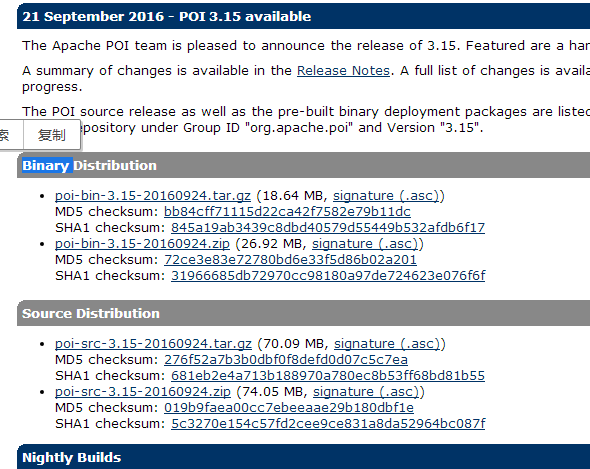
After downloading, open "poi-bin-3.15-20160924.tar.gz" to get the jar packages needed to operate excel, and copy these jar packages into the project. For excel, only poi-3.15.jar is required for 2003 and previous versions, and replication is required for both 2007 and later versions.
poi-ooxml-3.15.jar
poi-ooxml-schemas-3.15.jar
And copy the xmlbeans-2.6.0.jar in the ooxml-lib directory (but somehow there is no dom4j.jar in my jar file), or add dom4j.jar to prevent errors.
2. Using junit to operate Excel test
Firstly, we define Excel Workbook objects, worksheet objects, row objects, and cell objects.
The specific code is as follows: It should be clear whether it was before the 2007 version or after the 2007 version (including the 2007 version). The following code is before the 2007 version:
This code simply writes the data to the Excel file to create
public static void main(String[] args) throws Exception { /** * Note that this is just the suffix name of the excel file corresponding to the previous version 07.xls * 07 The suffix of excel file is. xlsx */ //Create a new workbook HSSFWorkbook workbook = new HSSFWorkbook(); //New worksheet HSSFSheet sheet = workbook.createSheet("hello"); //Create rows,Line numbers are passed as parameters to createRow()Method,The first line starts at 0. HSSFRow row = sheet.createRow(0); //Creating Cells,row The line number has been determined.,Column numbers are passed as parameters to createCell(),The first column starts at 0. HSSFCell cell = row.createCell(2); //Set the value of the cell,Namely C1 Value(first line,Column 3) cell.setCellValue("hello sheet"); //Output to disk FileOutputStream fos = new FileOutputStream(new File("E:\\root\\sheet\\11.xls")); workbook.write(fos); workbook.close(); fos.close(); }
The results are as follows:

Similarly, you can read Excel files, get the data of Excel files, and print them out. The code is as follows:
@Test public void testReadExcel() throws Exception { //Create an input stream FileInputStream fis = new FileInputStream(new File("E:\\root\\sheet\\11.xls")); //Passing parameters through constructors HSSFWorkbook workbook = new HSSFWorkbook(fis); //Get the worksheet HSSFSheet sheet = workbook.getSheetAt(0); //Get rows,Line numbers are passed as parameters to getRow Method,The first line starts at 0. HSSFRow row = sheet.getRow(0); //Get cells,row The line number has been determined.,Column numbers are passed as parameters to getCell,The first column starts at 0. HSSFCell cell = row.getCell(2); //Set the value of the cell,Namely C1 Value(first line,Column 3) String cellValue = cell.getStringCellValue(); System.out.println("The value of the first row and the third column is"+cellValue); workbook.close(); fis.close(); }
The results are as follows:
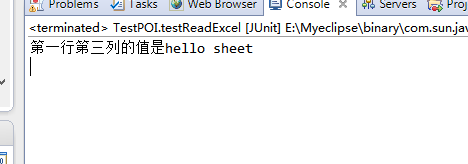
The above operations are all Excel files before version 07, that is, the suffix is. xls, and after version 07 and 07, the object name of Excel files suffix is. xlsx corresponding workbook is changed to:
//Create A Workbook XSSFWorkbook workbook = new XSSFWorkbook();
The code is as follows. Create excel file and save data to excel file.
@Test public void write07() throws Exception { //Create A Workbook XSSFWorkbook workbook = new XSSFWorkbook(); //New worksheet XSSFSheet sheet = workbook.createSheet("hello"); //Create rows,0 Represents the first line XSSFRow row = sheet.createRow(0); //Create cell line numbers from row Sure?,Column numbers are passed as parameters to createCell;The first column starts at 0. XSSFCell cell = row.createCell(2); //Assign values to cells cell.setCellValue("hello sheet"); //Create an output stream FileOutputStream fos = new FileOutputStream(new File("E:\\root\\sheet\\hello.xlsx")); workbook.write(fos); workbook.close(); fos.close(); }
Corresponding to the read data, the code is as follows:
@Test public void read07() throws Exception { //Create an input stream FileInputStream fis = new FileInputStream(new File("E:\\root\\sheet\\hello.xlsx")); //Get the workbook from the input stream XSSFWorkbook workbook = new XSSFWorkbook(fis); //Get a worksheet XSSFSheet sheet = workbook.getSheet("hello"); //Get the line,0 Represents the first line XSSFRow row = sheet.getRow(0); //Create cell line numbers from row Sure?,Column numbers are passed as parameters to createCell;The first column starts at 0. XSSFCell cell = row.getCell(2); //Assign values to cells String cellValue = cell.getStringCellValue(); System.out.println("C1 The value is"+cellValue); int a[][] = new int[10][30]; for(int i=0;i<a.length;i++) { System.out.println(i); } workbook.close(); fis.close(); }
The problem arises, which can also be interpreted as a requirement: when we are not sure whether to read Excel files before 07 (e.g. 2003, 95, 97, 2000) or after 07, we certainly hope that the program can automatically identify and create corresponding objects to manipulate excel files. The code is as follows:
@Test public void reda03and07() throws Exception { //Read version 03 or 07 String filePath = "E:\\root\\sheet\\hello.xlsx"; if(filePath.matches("^.+\\.(?i)((xls)|(xlsx))$")) { FileInputStream fis = new FileInputStream(filePath); boolean is03Excell = filePath.matches("^.+\\.(?i)(xls)$")?true:false; Workbook workbook = is03Excell ? new HSSFWorkbook(fis):new XSSFWorkbook(fis); Sheet sheet = workbook.getSheetAt(0); Row row = sheet.getRow(0); Cell cell = row.getCell(2); System.out.println("The data in the first row and the first column are:"+cell.getStringCellValue()); } }
After learning the above examples, the next step is to apply it. We often need to export and export data in batches in a page. Here we deal with the operation of excel files, and of course, other file formats. We use an lList < User > list to save it. Here we write an excel Util tool class: The code is as follows:
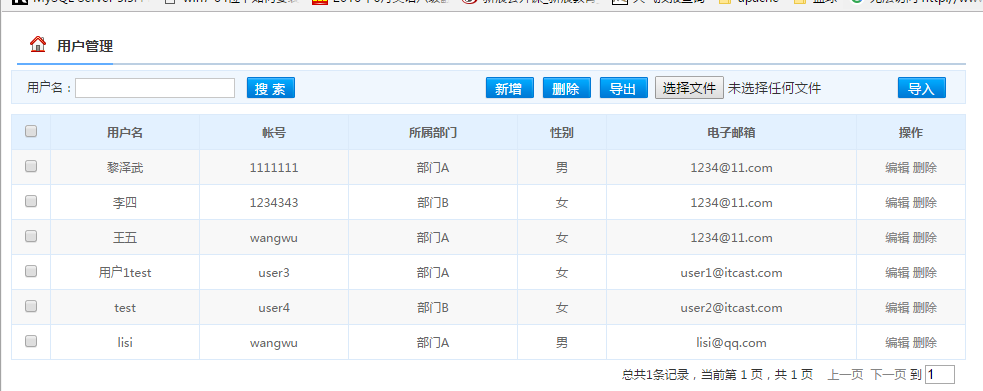
package com.ittax.core.util; import java.util.List; import javax.servlet.ServletOutputStream; import org.apache.poi.hssf.usermodel.HSSFCell; import org.apache.poi.hssf.usermodel.HSSFCellStyle; import org.apache.poi.hssf.usermodel.HSSFFont; import org.apache.poi.hssf.usermodel.HSSFHeader; import org.apache.poi.hssf.usermodel.HSSFRow; import org.apache.poi.hssf.usermodel.HSSFSheet; import org.apache.poi.hssf.usermodel.HSSFWorkbook; import org.apache.poi.ss.util.CellRangeAddress; import com.ittax.nsfw.user.entity.User; /** * excel Tool class to support bulk export * @author lizewu * */ public class ExcelUtil { /** * Import user information into excel file * @param userList User List * @param out Output table */ public static void exportUserExcel(List<User> userList,ServletOutputStream out) { try{ //1.Create A Workbook HSSFWorkbook workbook = new HSSFWorkbook(); //1.1 Create merged cell objects CellRangeAddress callRangeAddress = new CellRangeAddress(0,0,0,4);//Starting line,End line,Starting column,End column //1.2 Header Header Style HSSFCellStyle headStyle = createCellStyle(workbook,(short)16); //1.3 Column heading style HSSFCellStyle colStyle = createCellStyle(workbook,(short)13); //2.Create a worksheet HSSFSheet sheet = workbook.createSheet("User List"); //2.1 Load merge cell objects sheet.addMergedRegion(callRangeAddress); //Set default column width sheet.setDefaultColumnWidth(25); //3.Create rows //3.1 Create header header rows;And set the header title HSSFRow row = sheet.createRow(0); HSSFCell cell = row.createCell(0); //Load cell style cell.setCellStyle(headStyle); cell.setCellValue("User List"); //3.2 Create column headings;And set the column title HSSFRow row2 = sheet.createRow(1); String[] titles = {"User name","Account number","Subordinate departments","Gender","Mail box"}; for(int i=0;i<titles.length;i++) { HSSFCell cell2 = row2.createCell(i); //Load cell style cell2.setCellStyle(colStyle); cell2.setCellValue(titles[i]); } //4.Operating cells;Write the user list excel if(userList != null) { for(int j=0;j<userList.size();j++) { //Create data rows,There are two lines ahead.,Header header row and column header row HSSFRow row3 = sheet.createRow(j+2); HSSFCell cell1 = row3.createCell(0); cell1.setCellValue(userList.get(j).getName()); HSSFCell cell2 = row3.createCell(1); cell2.setCellValue(userList.get(j).getAccount()); HSSFCell cell3 = row3.createCell(2); cell3.setCellValue(userList.get(j).getDept()); HSSFCell cell4 = row3.createCell(3); cell4.setCellValue(userList.get(j).isGender()?"male":"female"); HSSFCell cell5 = row3.createCell(4); cell5.setCellValue(userList.get(j).getEmail()); } } //5.output workbook.write(out); workbook.close(); //out.close(); }catch(Exception e) { e.printStackTrace(); } } /** * * @param workbook * @param fontsize * @return cell style */ private static HSSFCellStyle createCellStyle(HSSFWorkbook workbook, short fontsize) { // TODO Auto-generated method stub HSSFCellStyle style = workbook.createCellStyle(); style.setAlignment(HSSFCellStyle.ALIGN_CENTER);//horizontally style.setVerticalAlignment(HSSFCellStyle.VERTICAL_CENTER);//Vertical Centralization //Create fonts HSSFFont font = workbook.createFont(); font.setBoldweight(HSSFFont.BOLDWEIGHT_BOLD); font.setFontHeightInPoints(fontsize); //Load fonts style.setFont(font); return style; } }
The next step is to call the method in UseService and write the exportExcel method:
@Override public void exportExcel(List<User> userList, ServletOutputStream out) { // TODO Auto-generated method stub ExcelUtil.exportUserExcel(userList, out); } @Override public void importExcel(File file, String excelFileName) { // TODO Auto-generated method stub //1.Create an input stream try { FileInputStream inputStream = new FileInputStream(file); boolean is03Excel = excelFileName.matches("^.+\\.(?i)(xls)$"); //1.Read workbooks Workbook workbook = is03Excel?new HSSFWorkbook(inputStream):new XSSFWorkbook(inputStream); //2.Reading worksheet Sheet sheet = workbook.getSheetAt(0); //3.Read rows //Judging that the number of rows is greater than two,Because the data is inserted from the third line if(sheet.getPhysicalNumberOfRows() > 2) { User user = null; //Skip the first two lines for(int k=2;k<sheet.getPhysicalNumberOfRows();k++ ) { //Read cells Row row0 = sheet.getRow(k); user = new User(); //User name Cell cell0 = row0.getCell(0); user.setName(cell0.getStringCellValue()); //Account number Cell cell1 = row0.getCell(1); user.setAccount(cell1.getStringCellValue()); //Subordinate departments Cell cell2 = row0.getCell(2); user.setDept(cell2.getStringCellValue()); //Setting Sex Cell cell3 = row0.getCell(3); boolean gender = cell3.getStringCellValue() == "male"?true:false; user.setGender(gender); //Setting up Mobile Phone String mobile = ""; Cell cell4 = row0.getCell(4); try { mobile = cell4.getStringCellValue(); } catch (Exception e) { // TODO Auto-generated catch block double dmoblie = cell4.getNumericCellValue(); mobile = BigDecimal.valueOf(dmoblie).toString(); } user.setMobile(mobile); //Setting up E-mail Cell cell5 = row0.getCell(5); user.setEmail(cell5.getStringCellValue()); //The default user password is 123456 user.setPassword("123456"); //User default status is valid user.setState(User.USER_STATE_VALIDE); //Save users save(user); } } workbook.close(); inputStream.close(); } catch (Exception e) { // TODO Auto-generated catch block e.printStackTrace(); } }
Finally, the service method is called in Action:
//Export User List public void exportExcel() { try { //1.Find User List userList = userService.findObjects(); //2.export HttpServletResponse response = ServletActionContext.getResponse(); //The file format set here is application/x-excel response.setContentType("application/x-excel"); response.setHeader("Content-Disposition", "attachment;filename=" + new String("User List.xls".getBytes(), "ISO-8859-1")); ServletOutputStream outputStream = response.getOutputStream(); userService.exportExcel(userList, outputStream); if(outputStream != null) outputStream.close(); }catch(Exception e) { e.printStackTrace(); } } public String importExcel() { if(userExcel!= null) { //Judging whether it is Excel file if(userExcelFileName.matches("^.+\\.(?i)((xls)|(xlsx))$")) { userService.importExcel(userExcel, userExcelFileName); } } return"list"; }
Note that you should use the ServletOutputStream class, and finally realize the batch export and import of data.
Export user results as follows.

The import results are as follows.
Before introduction:
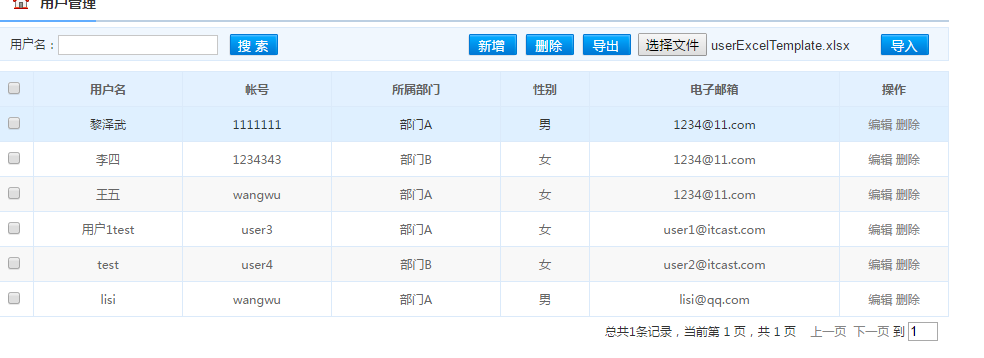
Results after importation;
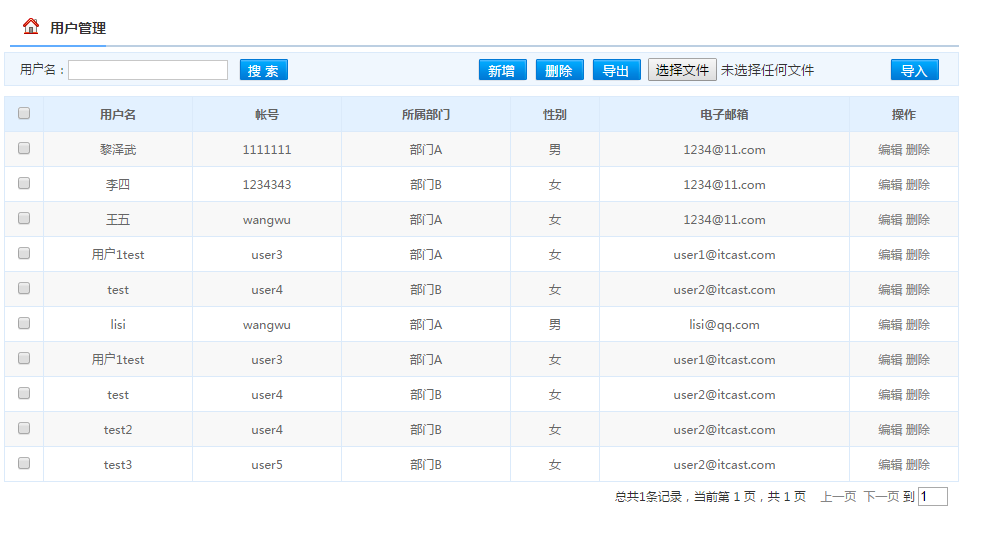
ok, so far as the POI operation EXCEL file is concerned